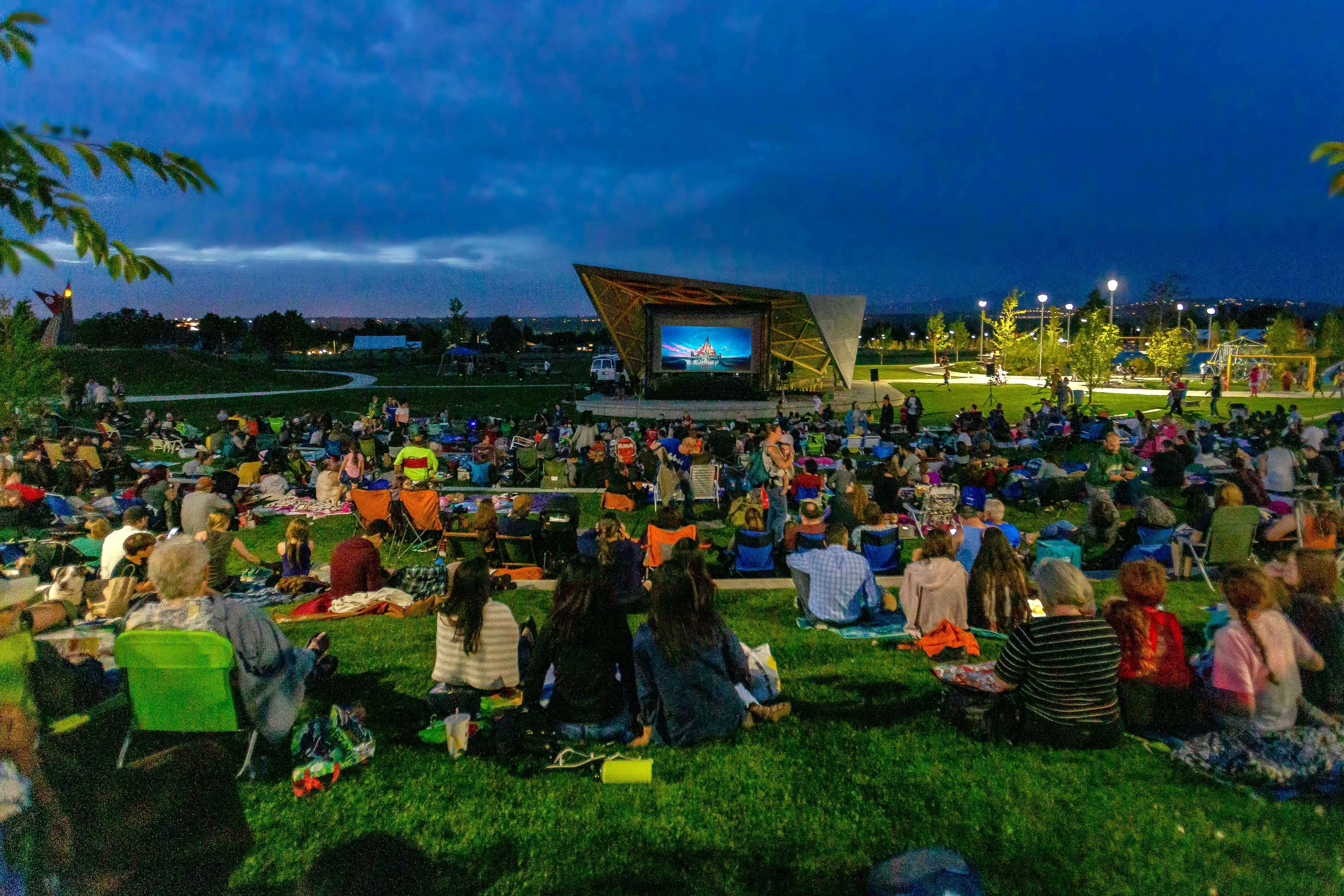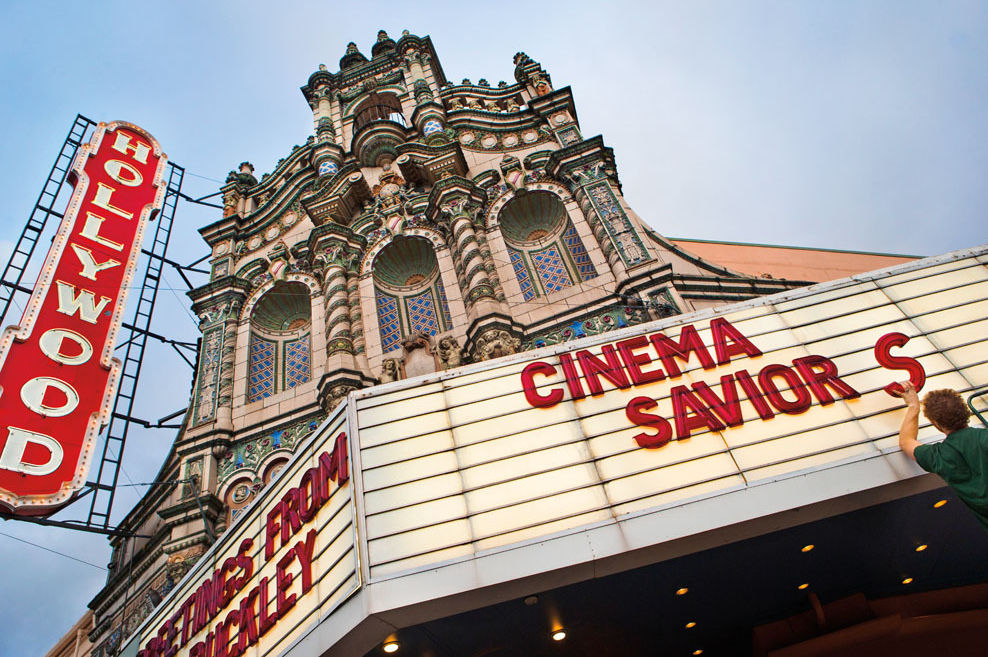
The New Hollywood Theatre
“Hey, you yellow dog! I’ve got dirty shoes, and I expect you to clean them!” bellows one of the drinkers. Barely parting his lips, the stranger replies, “Why don’t you get it done by that slut of a sister of yours?”
In the flickering light of this Spanish-Italian-Chinese mash-up of a movie, the cowbullies attack. But the mysterious visitor turns kung fu master, deftly flinging his fork to lance the leader’s meaty paw. The 400 people packing the Hollywood Theatre scream in delight.
The 90 minutes of crude racism, silly comedy, and hokey martial arts (a beating heart torn from a man’s chest draws the biggest cheers of the night) is not exactly a great movie. But in an introduction, the evening’s host, Dan Halsted, draws the audience into the 1973 relic with the panache of a sommelier proffering a distinctive Shiraz.
“There weren’t very many martial-arts spaghetti westerns made, but this is one of the best,” he says, explaining how the director tried to use kung fu to revive the dying spaghetti western genre. But then Halsted spears his audience quicker than a flying fork: “The only print available is owned by Quentin Tarantino. Quentin runs the New Beverly Cinema in Los Angeles, and I’ve helped him out a few times with films from my collection, so I called in a favor.”
The Tarantino loan may be exceptional, but the packed house is not. Over the past two years, the 87-year-old Hollywood Theatre has grown into arguably the city’s premier venue for cult and indie film. While many of its peers across the country fall casualty to the creeping convenience of Netflix, Amazon, and Hulu, the Hollywood has instead experienced two years of 50 percent jumps in attendance, thanks in large part to the growing synergies between a trio of film buffs: collector and programmer Halsted, executive director Doug Whyte, and director of programs and community engagement Justen Harn.
On any given night, growing squads of fans file in for everything from Z-grade action films to fringe cinema from local auteurs and archivists to amateur horror flicks inspired by the writer H. P. Lovecraft. Similarly, the historic movie house itself has become a collage of old, new, and recycled: behind the 1926 Spanish Colonial façade lie three auditoriums filled with a total of 609 seats and a Surround Sound system salvaged from the now-defunct Regal Broadway 4 Metroplex. Soon the theater will feature a state-of-the-art digital projection system and a restored Wurlitzer pipe organ. And later this summer, courtesy of $124,548 raised from 1,100 contributors to a Kickstarter campaign and helping hands from the likes of Neil Kelly Home Performance, the Hollywood will get a new old marquee—a modern, energy-efficient replica of the one it wore when the theater opened its doors.
“There are more butts in seats, and that’s the goal of any theater,” says Heather Petrocelli, a film historian with the Reel Portland project. “But the Hollywood is also redefining the moviegoing experience.”
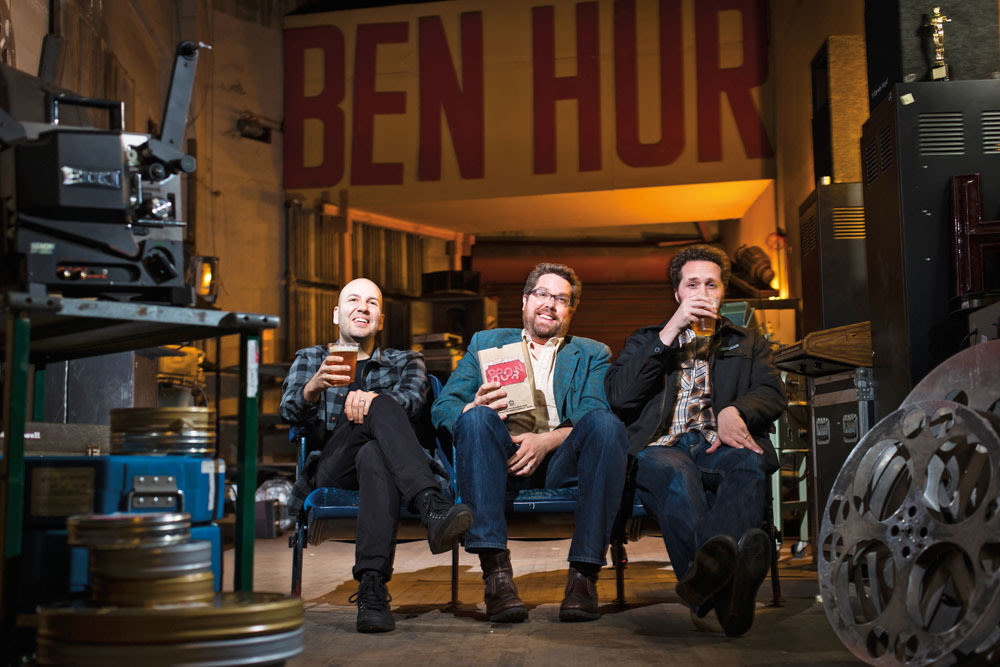
Image: Leah Nash
The bronze plaque to the left of the theater’s front door details an earlier time when the building was the central attraction for what was essentially Portland’s second downtown. Built for the then-princely sum of $500,000, it opened on July 17, 1926, with the silent comedy More Pay—Less Work, 1,491 seats, and a staff orchestra of 12 musicians. Named for the theater, the surrounding district blossomed with bungalows, apartments, and, eventually, three department stores, before I-84 spliced it into pieces with freeway lanes and a tangle of ramps.
In the decades that followed, the Hollywood’s fortunes waxed and waned under a succession of owners, the long lines for the Clark Gable films and war-bond drives turning by the 1980s into spotty crowds watching second-run movies (admission: $1.50) in the increasingly shabby environs. “It was dirty,” recalls local film writer and director David Walker, who put on the Portland Black Film Festival at the Hollywood in February. “There were roaches. People smoked in the theater. And the upstairs theater smelled like a urinal.”
The seeds of transformation began circuitously under the Oregon Film & Video Foundation, a project started by Gov. Barbara Roberts in 1992 to support local filmmakers. The foundation spun off from the state (it would eventually rename itself Film Action Oregon) and in 1997, led by then artistic director Richard Beer, bought the theater to restore it. (The 501c3 organization is now known simply as the Hollywood Theatre.) But the relatively conventional art-house fare of foreign and indie movies failed to yield black on the balance sheet. The nonprofit relies on volunteers for a lot of its popcorn popping and ticket selling, but with help from the Great Recession, by 2010 payroll checks weren’t clearing for its tiny paid staff, and the ledger showed a deficit of $73,000.
Yet, even in the crash, renewal still germinated. Hired as a technical director for the theater in 2004, lifelong film buff Halsted also occasionally rented it out for his Grindhouse Film Festival, showing borrowed prints and his own growing collection of titles, like Master of the Flying Guillotine and The Mystery of Chess Boxing. Harn, a University of Massachusetts and Oxford lit major whose career path had bounced from the financial world to Big Brothers Big Sisters, arrived in 2007 to expand the nonprofit’s educational offerings. But the big dose of fertilizer arrived with Whyte.
The 42-year-old Wisconsin native, whose laid-back looks belie a firm and decisive manner, had a finance degree and a 17-year résumé of successes, from coordinating a university film series to creating the Emmy-nominated International Documentary Challenge, a timed filmmaking competition in partnership with the Hot Docs Film Festival in Toronto. (He’d even directed a couple of well-received documentaries, including Pushing Up Daisies, a 2005 feature about funeral directors.) While launching an expansion of Documentary Challenge, Whyte and his wife visited Portland, fell in love with the city, and quickly relocated. “We knew we were going to spend the rest of our lives here,” he recalls, “so I started looking for ways to get involved.” He joined the nonprofit’s board and then, when the post was vacated, stepped into the captain’s seat. There were “a lot of problems,” he remembers, “but there was a really great staff. We can turn this around.”
The trio’s talents—Whyte the builder, Halsted the collector, and Harn the outreach specialist—coalesced. A flurry of grants, new donor and membership recruitment efforts, and on-screen advertising, not to mention the addition of beer to the concession stand, put the theater in the black and boosted the annual budget by a third, to over $1 million. But beyond cash (and pizza service, which debuted this spring), Whyte has nurtured community investment.
A recent walk-through at the theater finds several elderly members of the Columbia River Theatre Organ Society adjusting pipes and speakers for the newly restored Wurlitzer and, in effect, demonstrating what Whyte and his colleagues do best: adding 1+1 to get to 3. Besides paying for and installing the organ, the society’s members will play the organ for the silent films that are already being screened, while adding live musical pre-functions to other Hollywood nights.
Or take Joel Hamberg, a professional painter and film fan who grew up with the Hollywood (the first film he viewed there: Grand Prix, 1966). Invited by Whyte to do a little painting, he has now given the theater a bottom-to-tower, plaster-to-terra-cotta coating and cleaning—all pro bono. “It was like having a blank canvas,” Hamberg says. “Here was an opportunity to give back to a fallen-down old gem. How could I say, ‘I’ll only give a little’?”
Whyte says his formula is simple: “See what people are good at but also what they’re interested in, and let them run with that.”
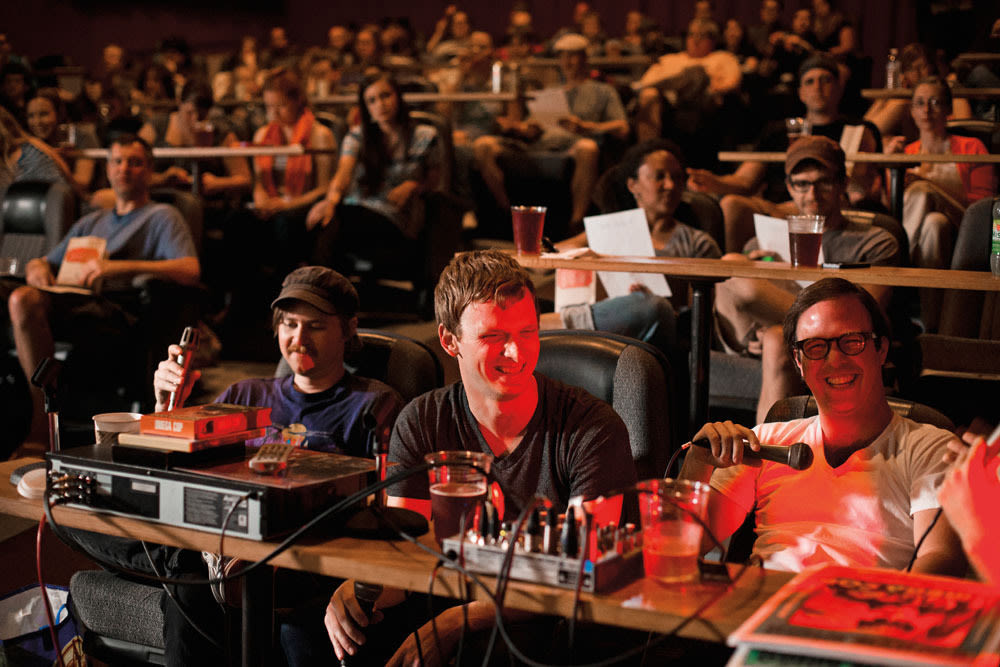
Image: Leah Nash
On an unseasonably warm night, one of the Hollywood’s smaller, second-floor theaters is so full that seatless souls are plopping onto the floor rather than miss Omega Cop, a laughably low-budget postapocalypse tale in the Mad Max mold. The film’s biggest star? Adam West, TV’s Batman, who spends the the movie in a not very futuristic control room yammering over a microphone to a rogue cop, who’s fighting to thwart slave traders who look like extras from a Loverboy video.
But the screamingly awful movie is only one part of the draw. The other is bingo. Each member of this keenly competitive and rowdy crowd holds a card gridded with well-worn action-film clichés: suitcases full of money, villains in white suits, hero walking away from an explosion, Uzis, flashbacks, etc. The object of this game, concocted in 2011 by a local art collective called Wolf Choir, is to spot enough of the clichés in the film to cross off a row. The winners take home movie passes, posters, and assorted memorabilia.
“He killed one of his own men!” shouts a silhouette down front. “That’s bingo!”
“No, the guy he killed was a friend,” a judge hollers back. “They didn’t have an actual employee-employer relationship. We’re looking specifically for the deaths of minions.”
The scene is many decibels away from the “ssshhh” of traditional cinema appreciation. But with a decidedly Portland spin, Harn has helped the Hollywood join a growing movement of venues like CineFamily in LA and the Alamo Drafthouse Cinema in Austin, Texas, asking the question, as he puts it, “What is a movie theater today?”
Wolf Choir offers one answer. The Hollywood’s wildly popular Hecklevision provides another. Borrowed in name and concept from Alamo Drafthouse, and fueled by a program called MuVChat, which displays viewers’ texted jokes and smart-ass commentary on the screen, Hecklevision is like Mystery Science Theater 3000 for the masses. “We pick hilariously horrible movies—but ones that we secretly love,” Harn says. Past selections include Point Break, Showgirls, Birdemic (with the director in attendance), Con Air—even presidential debates. A recent audience for 1997’s Batman and Robin broke the MuVChat record for text messages during a film—just shy of 9,000.
Whyte says the Hollywood is hardly the first movie house to do more interactive programming, but by necessity it may need to be one of the country’s best. The reason: competition. In many cities, he explains, a small theater can nab the first run of a Black Swan or The King’s Speech and float their other, artier programs for the rest of the year. But in Portland, Fox Tower’s 10 screens scoop those films up. “We have to get really creative,” he says. And so he is giving Halsted and Harn full tether to experiment. In June and running through the fall, the Hollywood launched “Future So Bright,” a series of programs ranging from the Internet Cat Video Fest to inviting performance artists like Andrew Dickson and A-list local interactive design firms like Second Story to, in Harn’s words, “imagine new ways to tell stories with technology, film, and performance.”
Meantime, Harn anchors the art-house side of the Hollywood’s programming in evenings with the likes of Todd Haynes, James Franco, and Gus Van Sant, while Halsted screens movies snagged through his deep connections and his own vast collection. (The 37-year-old earned the moniker “the Indiana Jones of film archivists” for the 1,000-plus reels of kung fu films he discovered in 2009 in a Vancouver, British Columbia, theater that had been closed since 1985.) “If you have a record of showing movies that people find interesting, they’ll continue to come back,” Halsted says. “I’ve always looked at the work I do at the Hollywood as like film school—but without the pretension.”
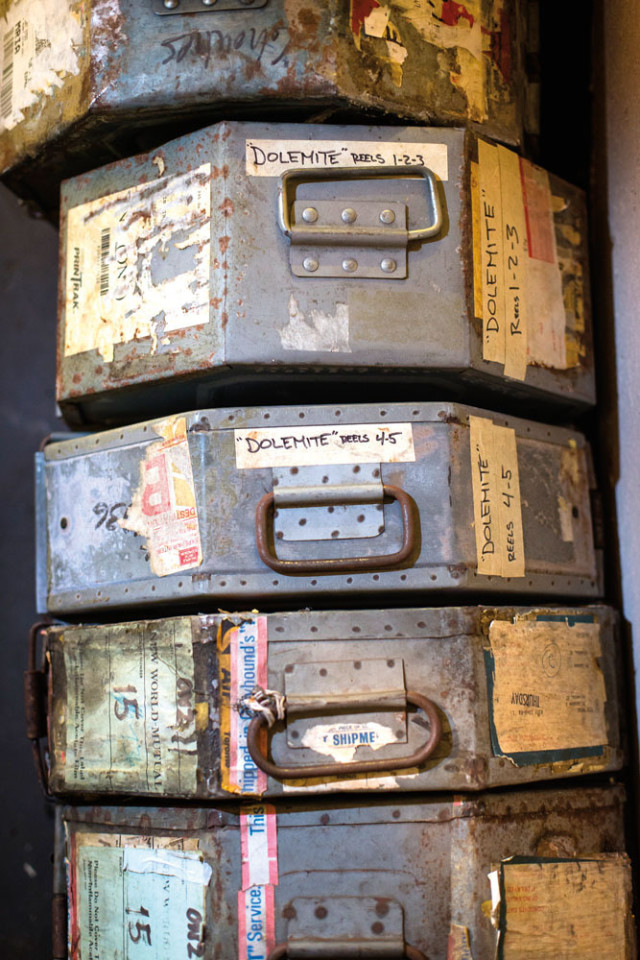
Dan Halsted's growing film collection has become a Hollywood mainstay.
Image: Leah Nash
It’s the second day of the annual H. P. Lovecraft Film Festival in May, a three-day assemblage of horror films inspired (some more overtly than others) by the late “weird fiction” writer from Providence, Rhode Island, who in his short lifetime created a popular and enduring mythos of malevolent deities (e.g., Cthulhu, Yog-Sothoth, Hastur). In a testament to the depth and longevity of Portland’s intensely eclectic film culture, the Hollywood Theatre has served as the outré gathering’s home for 16 years, the hallways crowded with vendors hawking Lovecraftiana games, books, and arcane jewelry. On-screen is an amateur-made movie from Gluckstadt, Mississippi, called Grasshopper! about a giant, child-eating insect.
Although the recent paint job, a roof speckled with new adobe shingles, and, soon, the new sign signal the Hollywood’s renaissance, inside, dimly lit hallways and the gurgling pipes in the walls reveal the ongoing challenges of the building’s still-original wiring and plumbing. But Wieden and Kennedy’s in-house school, Twelve, has opted to rebrand the theater pro bono. And all three theaters’ projection booths will soon feature state-of-the-art digital projectors courtesy of $160,000 in gifts Whyte stirred up from five foundations, the Oregon Arts Commission, and his own board. That’s crucial because major studios are likely to stop making 35mm prints as early as the end of this year. “It’s been likened to the change from silent to talkie films,” Harn says, in terms of the impact it will have on theaters. “Some won’t be able to afford it.”
By the end of Grasshopper!, an actor emerges tattered and bloody from a basement bearing the head of the giant insect. The audience—some dressed in Doc Martens and black T-shirts emblazoned with tentacled monsters—cheers both the heroism and the excellent construction of the bug’s head.
“Sometimes,” Harn says, “the best programming is to just get out of the way.”
See more of Leah Nash’s photographs from inside the Hollywood Theatre, plus videos of the architecturally iconic Rococo Tower’s refurbishing
